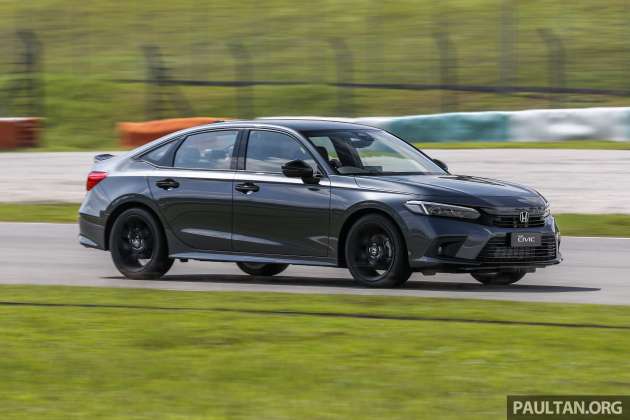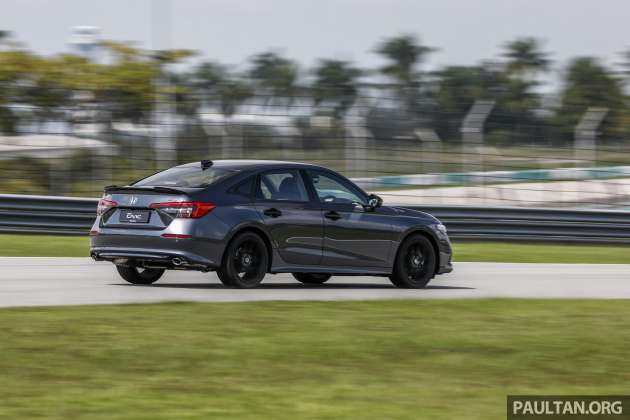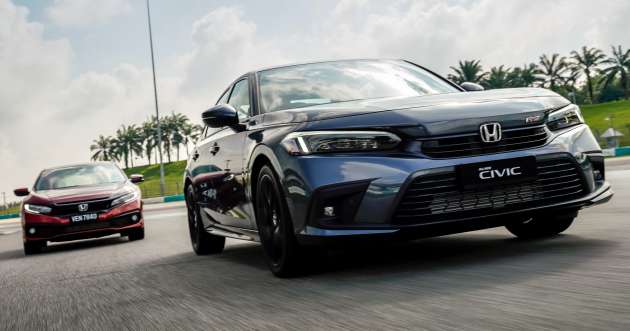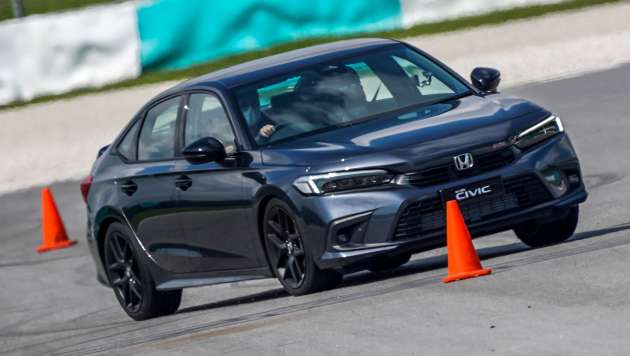It’s an unenviable position, being at the top of your game. Sure, it’s nice to reap the plaudits and successes, but the pressure to perform is immense, and your status as head of the field is anything but assured. Plus, there will be no shortage of pretenders chomping at the bit to dethrone you. Just ask Lewis Hamilton.
Honda finds itself in a similar situation with its Civic. Having woefully dropped the ball with the milquetoast ninth-generation FB, it left no stone unturned with the swoopy FC, which revitalised the flagging C-segment sedan market and turned an entire swathe of the buying public into diehard fans. The car itself was far from perfect, but it struck a chord with those looking for a sporty four-door, as its consistently strong sales show.
But having seen off a strong challenge from Korean competitors in the 2010s (the Mazda 3 and the much-improved Toyota Corolla remains a thorn in its side), the Civic now faces an attack from an unexpected corner – the affordable SUV. Proton has taken a significant chunk of the market with the popular X50 and X70, which is squeezing the car into a tight spot. Couple that with the steady erosion of Honda’s range-wide pricing advantage and Civic runs the risk of becoming an also-ran.
The only way out of the situation is by giving buyers more car for their money, which is why the new 11th-generation FE promises a more premium look and feel, a punchier engine and sharper dynamics. But will the latest Civic be good enough to please the Type-R-badge-from-Shopee brigade already up in arms over the more mature styling? Honda Malaysia gave us a preview drive in Sepang to find out.
We should point out at this juncture that we were only allowed four short laps around Sepang’s South Circuit, so we didn’t get a chance to test the new Civic out on the road. This was effectively a taster that gave us a feel of what the car was like at the limit, if not to live with. Honda Malaysia did not provide pricing, but it has just opened the order books ahead of a scheduled launch in the first quarter of 2022.
Only the range-topping RS was shown during the event, although a leaked memo suggested that a cheaper E variant will also be offered. It remains to be seen if the more premium positioning will lead to a sharp increase in price – we’ll only know for sure after the launch.
This positioning will at least be reflected in the Civic’s more grown-up exterior, although that comes at the expense of those who loved the FC’s extroverted styling. Gone are the full-width “Solid Wing Face” front bar, flared fenders and “ketam” C-shaped taillights, replaced by straighter body lines, Audi-style trapezoidal LED taillights and a polarising jutting “forehead”.
Still, the FE does look aggressive up front with its slim and broad headlights and a large centre air intake, while the returning C-pillar kink breaks up the monotony of the side profile. The effect is a mini-Accord of sorts that probably won’t lend itself quite as well to the myriad of lights, bodykits and spoilers favoured by the FC faithful, but I’m sure the aftermarket will find a way.
Adding some sportiness back to the mix are the RS-specific touches that include LED headlights with darkened internals, matte black side window trim, visible twin tailpipes and gloss black highlights on the wing mirrors, door handles and unique rear spoiler.
There are also a smattering of RS badges, and while the Thai- and Indonesian-spec models have to make do with modest 17-inch alloy wheels, we get the same 18s found on the US and Japanese cars, coming with a handsome Y-spoke design and a matte black finish.
Against the measuring tape, the new Civic is 4,678 mm long, 1,802 mm wide and 1,415 mm tall, making it 30 mm longer, three millimetres wider and one millimetre lower than before; its 2,733 mm wheelbase is also 33 mm longer. Honda says that the latter provides more legroom, especially for rear occupants.
We aren’t able to show you the interior of the car, but we do know that the Civic will come with a more upscale interior than the outgoing model. International photos show a clean horizontal dashboard, a freestanding infotainment touchscreen and full-width air vents with a honeycomb metal mesh cover. The company promises improved material and switchgear quality in concert with the more upmarket look, as well as increased visibility thanks to the A-pillars being pushed 50 mm rearward.
In terms of safety, the RS comes with the Honda Sensing suite of driver assistance features, which include autonomous emergency braking, adaptive cruise control with stop and go, lane centring assist, lane keeping assist and automatic high beam. New for the FE is a Lead Car Departure Notification System, which alerts the driver if the car in front is moving off from a stop. It remains to be seen if the entire package will be offered as standard, as is the case in Thailand. Honda’s LaneWatch blind spot camera is also fitted to the RS.
Powering the RS is a 1.5 litre VTEC Turbo four-cylinder engine, now with actual VTEC (variable valve lift). Unlike in Thailand, we get the full outputs offered in America and Japan, rated at 182 PS at 6,000 rpm and 240 Nm from 1,700 to 4,500 rpm (up 8 PS and 20 Nm). All this is sent to the front wheels via the usual CVT. The aforementioned memo stated that, as per Thailand, the base 1.8 litre naturally-aspirated mill will be dropped for the FE – again we will have to wait and see if this is actually true.
At Sepang, Honda Malaysia wheeled out both an FC Civic 1.5 TC-P as well as a Corolla 1.8G for us to make a back-to-back comparison with the FE. Accelerating hard out of the gate, the first thing that struck me was just how refined the new car was compared to the outgoing model. Yes, with the CVT, the engine was still screaming at the redline, but it was quieter and had a much smoother sound compared to the previous mill, which was really rather raucous on the throttle.
Despite the extra power and torque, the FE didn’t feel noticeably more muscular than the FC. As before, the engine lacked the distinct shove in the back of a boosted European mill, instead building speed in a linear fashion – almost as if it was a much bigger naturally-aspirated engine. Both the FE and FC had the measure of the Corolla in straight-line performance, despite the latter’s larger cubic capacity.
The revised CVT made more of a difference to the way the new Civic drove. It responded marginally quicker to throttle inputs, but the biggest improvement was the simulated gear changes using the paddle shifters. Instead of excessively slurring its “shifts”, the transmission moved up and down the virtual ratios in a much snappier and more natural manner, acting like a modern automatic or even a dual-clutch transmission.
The dreaded CVT whine was still there, of course, but it was much more muted compared to the (admittedly tired) FC example, the transmission of which protested audibly at higher revs. The big speeds that we were carrying on the straights (in excess of 150 km/h) meant that assessing road and wind noise was difficult, but for what it’s worth, the FE didn’t feel any noisier than the FC, which was already one of the more refined cars in its class – if you excluded the engine and CVT, of course.
Honda promised some improvements under the skin, including a stiffer body structure, increased sound insulation and a retuned chassis aimed at delivering a better ride and handling balance. The new Civic also comes with a new Sport mode, activated by a centre console toggle switch, which sharpens the throttle and CVT response and adds more weight to the steering for a more engaging driving experience.
Despite being a family-friendly road car, the new Civic acquitted itself on the track, taking on high-speed corners with aplomb. The steering was direct and nicely weighted, and I could simply aim the car at the apex and trust it to get there. And it held its line once it did, thanks to the excellent body control and the incredible grip coming from the Michelin Pilot Sport 4 tyres, the car hardly understeering even when pushed.
Approaching the braking zone for the tight Turn 9 hairpin, the Civic tracked straight and true and generated a strong brake pedal feel, giving me the confidence to attack the corner. It then kept its poise through the uphill turn and was able to carry good speed through the Turn 12 and 13 esses without feeling nervous – the mark of a good chassis. The Civic was also nimble and composed through a slalom set up on the back straight.
Of course, it’s hard to assess the full breadth of the Civic’s talents on the race track, and we’ll have to reserve judgement of the car until we can conduct a proper test drive. However, the fact that it can withstand some circuit abuse bodes well to its capabilities out on the open road. It’s early doors, but it appears the new Honda Civic could well be a formidable enough opponent to keep its crown.
Source: Read Full Article










